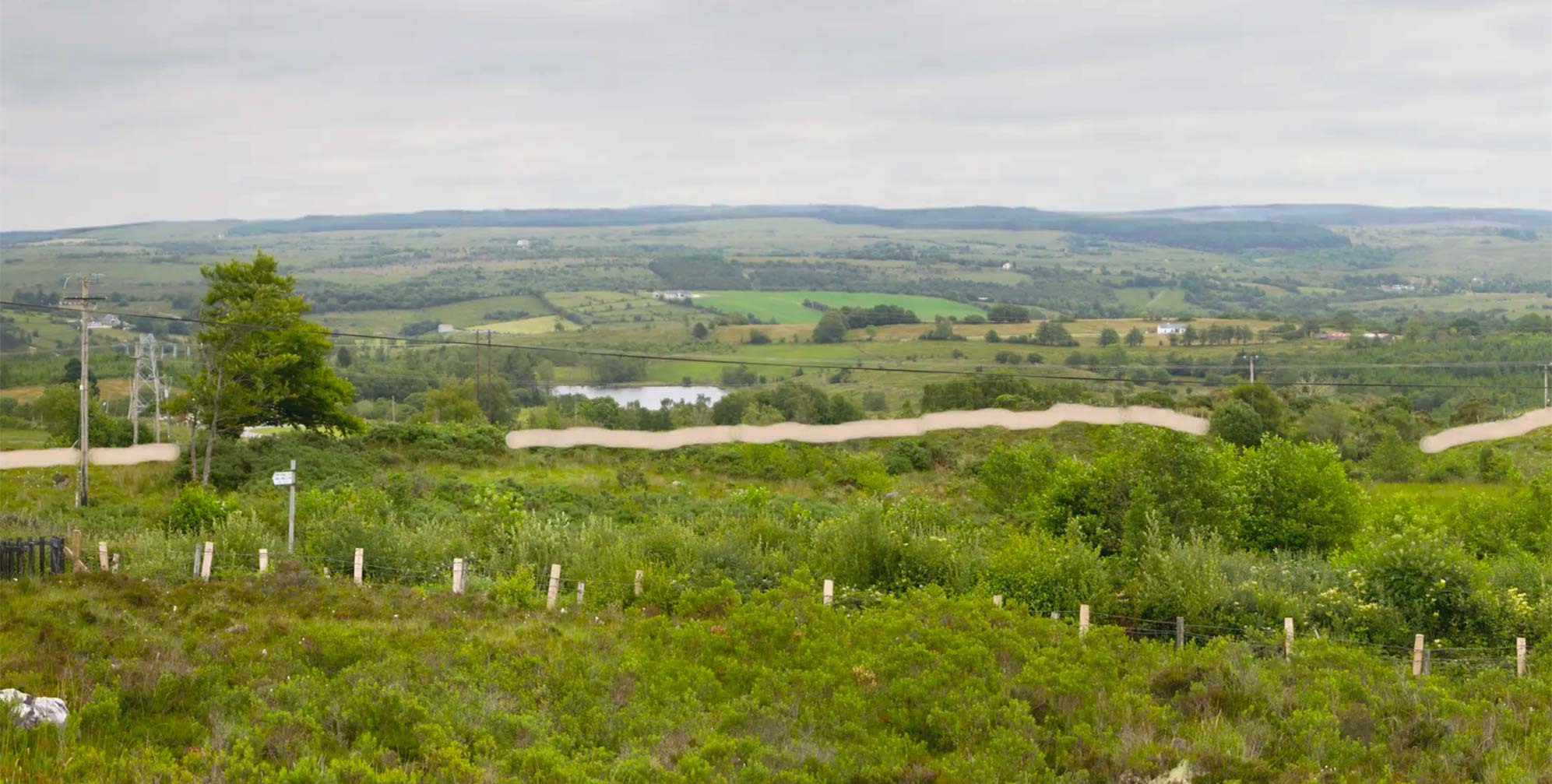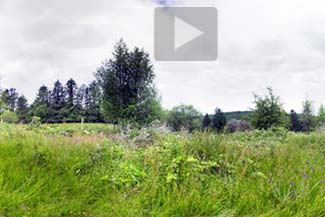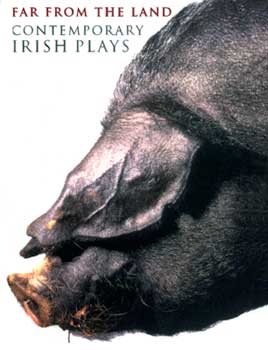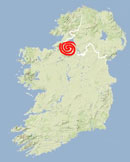28 Nov The Black Pig’s Dyke
“But my attention was especially arrested by the vestiges of a great embankment and ditch running along the county verge, most of which has been leveled, but sections of which still remain in fair condition, and challenge notice by their huge size…The names attached to the earthwork are strange: ‘The Black Pig’s Race,’ or ‘Rut,’ or ‘Valley,’ the ‘Worm Ditch,’ or ‘Dyke.’ The legends attached to the former name are very grotesque; and their main drift is that a magical pig, originally from Meath, raged westward through Ireland, and tore up this deep furrow with its snout.”
W.F. De Vismes Kane, 1908 1
The Black Pig’s Dyke (Claí na Muice Duibhe) belongs to a class of ancient monuments known as a “linear earthwork,” so called due to its great length, with a construction of multiple banks and ditches.2 Discontinuous sections of the Black Pig’s Dyke, known by different names in different areas, have survived in Counties Leitrim, Fermanagh, Longford, Cavan, and Monaghan.3 In most sections the Dyke consists of a bank with 3 m (10 ft) ditches on both sides, the bank usually about 9 m (30 ft) wide and originally perhaps 6 m (20 ft) high. Excavation in 1982 (see below) of a stretch of the Dyke revealed evidence of a timber palisade, with charcoal found in its trench dated to 390-70 BCE; other sections of the Dyke are likely from the same period of the Irish Iron Age.
Modern archaeologists, with this dating information, have abandoned the earlier belief that the Black Pig’s Dyke was constructed as a rough imitation of the Roman walls designed to guard the frontiers of an empire. But the Dyke was indeed a frontier of sorts: it likely provided a barrier against cattle raiding. Since cattle could not be driven across a fosse (bank) with a ditch on each side, the Dyke served to funnel the outlaws, as well as legitimate commerce, to specified crossings that might be more easily defended.4 It is probable that the Black Pig’s Dyke was intended to defend the ancient northern kingdom of Ulster (the Uladh or the later Airgíalla) from the cattle-raiders coming from the south.5
Because some of its segments correspond roughly to the modern borderlines separating the Republic of Ireland from Northern Ireland, the Black Pig’s Dyke has supplied ancient superstition—and a modern dramatist—with a symbol of the bloodstained divisions of the two communities sharing the island. But the compelling story of a shape-shifting magician is the tale that gave the Black Pig’s Dyke its name.
The narrative of the wicked schoolmaster and his dark magic has been recorded in all the locations of this linear earthwork. Echoes persist in the modern era: as noted in the video interview (below, right) parents might warn their children to return home early lest they come to harm by crossing the Black Pig’s Dyke.6 While there have been at least 50 different examples of this story collected by folklorists, a characteristic telling of the tale was recorded in the townland of Lattone, Kiltyclogher, Co. Leitrim, by R.S. Rogers in 1957 from 76-year-old farmer John Quinn, whose land was crossed by the Dyke. Our virtual-reality panorama (below, left) was photographed a short distance to the SE of this townland.
“A man remarked that his son was greatly failed; and he was going to school and he says to him what is the cause he says that you’re so much gone every day: you’re getting the same diet as the rest of the family. The young lad says, ‘the master puts us into different shapes, and he makes me a hare and the others hounds and they run after me. And I run at the same fret as a hare every day. And then through the power of this book, he turns us back every evening to our usual selves.’ Then the father says to him, ‘I’ll go to the school tomorrow.’ So the father goes to the school and he says to the teacher: ‘is it true that you can do these things?’ And he said he could, so he says, ‘change yourself now into a pig.’ So the master turned himself into a pig, and the man took the book, and the master was in the form of a pig and he couldn’t take it from him and he burned it in the fire. So the pig lost his senses altogether when he saw this and he ran through the country tearing up the land as he went. And somewhere in the neighbourhood of Tullaghan he ran into the sea and was drowned.” 7
In his articles published in 1908 and 1916 in the Proceedings of the Royal Irish Academy, the antiquarian author W. F. De Vismes Kane brought the stories, and the extent, of the Black Pig’s Dyke into the public eye. Undaunted by the fact that, as he admitted, “many parts of the work have been either partly or entirely obliterated,”8 Kane proposed not one but three routes, or stages, for the Dyke, which he considered the “Ancient Boundary Fortification of Uladh” [Ulster]. Basing his conclusions for the whereabouts of lost segments of the Dyke on medieval literature and folklore, Kane suggested a total length for the linear earthwork of 209 km (130 miles).9
In the interactive map to the right, Kane’s path for the third of his proposed routes of the Black Pig’s Dyke is indicated. If you move your cursor into the image you will see those segments of the Dyke ultimately confirmed by the archeological record delineated in green. Click on the map to see, in a larger window, the entire map as drawn by Kane, with all three of his routes included.10
Dismissively summing up Kane’s conclusions, Oliver Davies wrote in 1955:
“Kane chased the Black Pig; where there was no entrenchment on the ground, place-names or traditions about this animal sufficed to construct his frontiers. But the Black Pig and the Worm are among the obscurities of Irish folklore; there is no evidence that places or monuments associated in tradition with either of these creatures are contemporary or parts of a single or similar systems…Moreover, ancient folk-tradition has been contaminated with the theories of 19th-century antiquarians.” 11
Verified remnants of the Black Pig’s Dyke are found in:12
• Co. Leitrim, running NW-SE, from Lough Melvin to Lough MacNean, near Rossinver and Kiltyclogher.
• Co. Fermanagh, in Lislea and Mullynavannogh townlands.
• Co. Longford, running NW-SE from Lough Gowna to Lough Kinale, near Dring and Granard.
• Co. Cavan, E of Bellanagh, in the townland of Ardkill.
• Co. Monaghan, running W-E from the Finn River to the townland of Corrinshigo, near Drum.
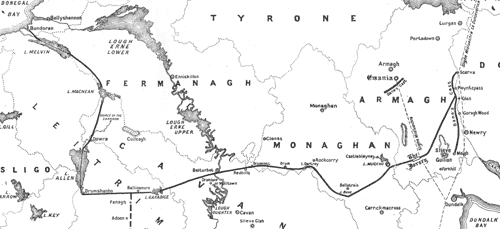
In 1908 and 1916 W. F. De Vismes Kane wrote of the Black Pig's Dyke as three stages of the frontier of the Kingdom of Ulster. He filled gaps by making extensions of the routes from literature and folklore (Davies, 1955). Move your cursor into this map to see Kane’s third stage of the Dyke with green indicating those portions of his route confirmed by archeological evidence. Click to see the entire map.
“Cavan may have the reputation as having the most liberal planning regime in Ireland but while this may benefit big business and those who want to make a quick buck by building throughout the countryside, Cavan will reap the rewards of such short sightedness in the future when we have destroyed our heritage and polluted the countryside…” 14
Due to its numerous appearances, running clear across the Irish borderlands, it would be remarkable if the Black Pig’s Dyke had not suffered depredations through the years. From the farmer quietly plowing over the linear barrier to his cultivation, to the modern planning council’s obliviousness to the importance of cultural heritage, great sections of the Dyke are likely gone forever. Kane wrote of a section of the Dyke—locally known as the Worm Ditch—in Co. Monaghan that was destroyed around 1820 by a farmer, with further land clearing made by his son about 1860.13
Much more recently, despite protests and three years of organizing efforts by the local Red Branch Heritage group, a quarry company in Co. Cavan was given planning permission to continue its work adjacent to a section of the Black Pig’s Dyke at Ardkill More. Earlier quarrying at the site had obliterated 183 m (200 yds) of the monument. With the Cavan Planning Authority’s decision in 2006, Red Branch Heritage released a statement:
Near the same area south of Scotshouse, Co. Monaghan, where in 1820 the farmer obliterated the Worm Ditch, archaeologist Aidan Walsh in 1982 excavated within a well-preserved 130 m (142 yd) section of the Dyke. This was the first professional research undertaken on the monument anywhere along its extent. The Dyke here, with a total length of 9.5 km (6 miles), consists in the excavation area of a double bank and ditch, with a combined width of 24 m (79 ft). Walsh’s research uncovered evidence of a wooden palisade fence about a meter (3.3 ft) to the north of the earthwork banks of the Dyke. Evidence suggested that the palisade timbers were some 30 cm (1 ft) wide, perhaps consisting of trunks of oak trees. Charcoal found in the palisade trench allowed Walsh to date the structure to the first few centuries BCE. A photograph of the 32 m (105 ft) excavation trench may be seen in the gallery at the bottom of this page.
Following his excavations, Walsh concluded that the Black Pig’s Dyke was actually a triple-defensive line: banks, ditches, and a palisade of timber protecting the rear. He consider the charcoal as evidence that the structure was “deliberately and quite fully destroyed, presumably during wartime.” The excavator speculated that the destruction of the Dyke was somehow connected to a war that also saw the burning of the capital of the Ulaidh, Emain Macha (Navan Fort).15
At a section of the Dyke far to the east of this spot, close to Slieve Gullion, Kane’s 1908 research discovered “…lines of piles, upon which foundation no doubt the ramparts were raised…The peasants remember the oak piles with collars of the same attached; whence they say the ditch ‘went out into the country and away through Ireland.'”16
The linear earthwork is known by other names in some localities; names which each come with an explanation in folklore. In the eastern part of the extended dyke plotted by Kane, in Cos. Armagh and Down, the monument is known as the “Danes’ Cast,” due to ancient belief that they were built by the Vikings. An 1896 article quoted a local farmer about the structure:
“The Kings of the Danes lived in Lisnagade, and had this ‘Cast’ made for a way through which to march their army out of sight of their Irish enemies to Warrenpoint, where they had their ships.” 17
In parts of Cos. Monaghan and Cavan, the monument has inspired tales of a quite different creature than a Black Pig. There the rampart goes by the name “The Worm Ditch,” with the story of an immense and horrific worm—perhaps a dragon or serpent—that writhed and wrecked it way through the land, tunneling through the earth and forcing it up into the long rampart we see today.

Una Braden (right), shown here with Sr. Mary Oliver Braden, recounts the folklore of the Black Pig’s Dyke (1998).
The earthwork travels through a townland in Co. Monaghan known as Cornapaste, which in its original Irish means “the hill of the serpent.” An Irish Folklore Commission entry on the townland, collected in the 1930s, included the tale of a “huge oll-phéist or serpent, which in its journey across the hills and valleys, left this rampart in its wake.”18
In his second article on the Black Pig’s Dyke, W.F. De Vismes Kane in 1916 considered the possibility that the Dyke was in fact the landmark mentioned in the epic Táin Bó Cúailnge where the superhuman hero Cúchulainn finally met his death at the hands of Lugaid, whose father Cúchulainn had killed at the mountain fortress of Caherconree. When the hero knew that he was about to die he bound himself to a pillar-stone before he expired so that he might continue to inspire his warriors. When Cúchulainn’s foster-brother Conal came upon the scene he said of the rampart nearby, “I swear to you, says he, by the, oath which my nation made, that one will call this rampart the ‘Rampart of the Great Man.’” Kane pointed out that the Ordnance Survey research concerning the Black Pig’s Dyke near Lattone found that the rampart there was known as “The Great Man’s Track.”19
Beyond the tale of the schoolmaster transformed into the Black Pig, Irish folklore includes a number of other stories featuring swine in one form or another. In his 1872 Rude Stone Monuments, James Fergusson explained how the townland of Kilamucky, the “Cell of the Pig,” near Castlemartyr in Co. Cork, got its name:
“Long ages ago the race of pigs increased throughout Ireland to such an extent that at length the people assembled and destroyed them all except a boar and two sows…These, being magical pigs, escaped all snares laid for them, and kept the surrounding country in terror by their depredations. When the first of the Geraldines came to Ireland he determined to kill the monster, and he succeeded in his attempt, but unfortunately left the dead animal uninterred, and the decay of the carcass occasioned a pestilence which swept away the people by thousands. The remains of the boar were then buried, and a large megalithic monument was erected over it at Kilamucky…This monument, however, was destroyed in the year 1844.” 20
The Black Pig himself has undergone a folkloric evolution to keep abreast of the changing landscape. When an author of a 1957 article was collecting stories in the countryside, she was told in two different villages that the Black Pig was a symbol for the railway making its tracks throughout the land.21
One tradition of the Black Pig’s Dyke has an origin in folk memory that may have begun with the early Norman conquest. This is the so-called “Prophecy of St. Colm Cille,” which predicted “…a massacre that is believed shall be perpetrated upon the mass of the Catholic population of Ulster by their Protestant neighbors, in ‘Gleann na Muice Duibhe’ (Valley of the Black Pig).”22 This ominous folk tradition is even buttressed by a detailed explanation of the supposed mechanism of the massacre:
“‘The massacre will begin, after the putting out of a false notice all over Ireland to lull the Catholics into security, at II o’clock on a Sunday night,’ the squadrons of the enemy having put to sea on Friday. There will be a thick mist and fog, and on the day of the carnage it is to be as dark as night, ‘and will be so all over the Valley of the Black Pig, unto the end of the business, which will last and continue for four nights and three and a half days…'” 23
Kane reported hearing a folk tradition in the west of Co. Monaghan where the country people believed that “when the great war arises they must escape west of the Cuilcagh mountain beyond…the source of the Shannon.”24
While numerous writers have repeated this frightening prophecy, along with its attribution to the 6th-century saint, nowhere in the biographies of St. Colm Cille is there a mention of any cross-border bloodletting to come. The sense of doom prevailing in this ersatz prophecy, however, was compelling enough to provide it lasting resonance in folk belief. John O’Donovan, in an 1837 letter, described a tradition near the Curragh of Kildare:
“They assert that the feature called the Race of the Black Pig is mentioned in the prophecy of St. Columbkille as a place that is to be the scene of dreadful slaughter towards the end of the world. A black pig will, it is added, run over that track and destroy all before it. It is curious to consider with what confidence the country people refer to the Book of Columbkille for a corroboration of wild stories of this description.” 25
Nicholas O’Kearney, who authored his own bogus saints’ prophecies in 1836, pointed out the negative effects of the popular belief in the Valley of the Black Pig massacre prophecy:
“This erroneous and wicked prophecy has done much harm… for, whenever any little commotion darkened the political horizon, families not unfrequently, in order to avoid the carnage, fled the country, or province, a circumstance which has caused the ruin of many who might have been comfortable and highly respectable members of society, had they remained at home. This delusion put upon the people was not less injurious than the stern decree ‘to hell or Connacht’ had been, in its day of wicked career.” 26
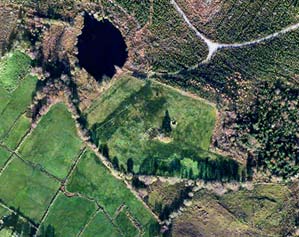
This is a satellite view of the Corracloona segment of the Black Pig’s Dyke.
The first mention of the prophecy may have been in Expugnatio Hibernica (“Conquest of Ireland”) by Giraldus Cambrensis (Gerald of Wales) in 1189. His privileged Anglo-Norman roots might have made him supportive of a scenario such as that depicted in the prophecy, with all the native Irish fleeing south from Ulster to avoid the massacre. Thus it may be that the “Prophecy of St. Colm Cille,” was nothing more—or less—than a diabolical politically inspired rumor originally set in motion by Giraldus to inform the native population of Ireland that the violent colonization of their land was foretold by Colm Cille, one of their most revered saints. It is also possible that the folk memory of the so-called prophecy is merely the result of some 19th-century pamphleteering.27
The toxic effects of the belief in this supposed horrific prophecy of St.Colm Cille may have caused two little girls in Co. Roscommon to claim an apparition visited them in the shape of the Black Pig. This resulted in “tremendous excitement in the district, where the people believe that this is the ‘black pig’ spoken of in the prophecy of Columcille.” This was reported in two dispatches to the Irish Times dated 27th April 1918:
“The scare over the apparition of the “black pig” at Kiltrustan is growing, and hundreds are visiting the place daily, but none can see the pig but the two little girls who first saw it, and a companion… many people who live in the district believe implicitly that the children did not lie. That the appearance of the black pig portends serious trouble in Ireland is generally believed, and legends relate that all along and north of the valley of the Black Pig there will be awful slaughter of the Irish race.” 28
The connection in folklore of the Black Pig to the centuries of conflict between the communities on either side of the Dyke was the inspiration for Vincent Woods’ 1992 play, At the Black Pig’s Dyke. Using pagan-costumed mummers (see photograph in gallery) to symbolize the continuity of ancient tribal hatreds, the play is set on the borderlands of Cos. Leitrim and Fermanagh, where young men leaving for an evening’s bloody vengeance are said to be “out raising the black pig.”29 In the play’s prologue, a mother speaks to her infant daughter:
“It was a long time ago, Elizabeth, and it was not a long time ago. It was a time when to go east was to go west, when to go south was to go north, when people sang songs at a wake and cried when a child was born. It was in a land where the sun never rose and the sun never set, where the dead prepared shrouds for the livin’ and straw people walked the roads.
…[The scene abruptly shifts; the daughter, now grown says…]
It was not a long time ago at all and it was not far away. It was in a land where the black pig had furrowed an endless tunnel under the earth and where it ran still, trapped and frantic beneath the ground.” 30
William Butler Yeats understood that the legendary Black Pig was in the popular imagination a symbol for the murderous enemies of the Irish people. Yeats knew that these legends must also be appreciated on a political level: He remembered a man who would not support organizing against the absentee landlords because he felt it important to delay the battle until the end of the century, when the cross-border Armageddon promised by the prophecy was set to occur. Yeats believed that the battle had an origin in ancient mythology, and that the Black Pig was likely a metaphor for “…winter doing battle with the summer, or of death battling with life.”
The Valley of The Black Pig
“The dews drop slowly and dreams gather: unknown spears
Suddenly hurtle before my dream-awakened eyes,
And then the clash of fallen horsemen and the cries
Of unknown perishing armies beat about my ears.
We who still labour by the cromlec on the shore,
The grey cairn on the hill, when day sinks drowned in dew,
Being weary of the world’s empires, bow down to you,
Master of the still stars and of the flaming door.”
William Buter Yeats, 1896 31
Click here to see all the notes from this page.
The Black Pig’s Dyke, Co. Leitrim
Nearest Town: Kiltyclogher
Townlands: Kiltyclogher and Corracloona
Kiltyclogher Position:
Latitude: 54° 21′ 25.40″ N
Longitude: 8° 2′ 6.14″ W



